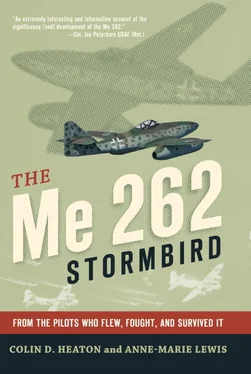The other part of the 262 story, of course, is the Allied perspective. The author not only presents detailed tables for reference, but allows U.S. and British airmen to speak for themselves. How they coped with the sudden appearance of enemy aircraft that outstripped their fighters by 100 miles per hour is well worth studying.
Fighter pilots being what they are (let’s face it: they’re supreme egotists), it’s instructive to note the prestige attached to downing a jet. Then Lt. Col. Gabby Gabreski, the leading American ace in Europe, is quoted as saying he would have traded half his total victories for one confirmed jet kill.
Those of us privileged to have known “the greatest generation” of aviators recognize that the biggest difference among combat airmen is the paint on their airframes. The World War II generation not only fought a unique war but flew a fabulous variety of aircraft that can never be matched. Consider this: The men who learned to fly in biplanes during the early 1940s finished their careers in jets capable of Mach 2. That kind of progress can never occur again. Meanwhile, the ghastly prices for twenty-first-century aircraft ensure that there will never be another air war on the scale of Korea, let alone World War II.
So sit down, strap in, and turn up the oxygen regulator to 100 percent with the gun sight set for 30 mils. You’re in for a rare ride.
Aviation history has always fascinated me since I was a boy, and as the years passed, I was fortunate to have met and gotten to know dozens of combat pilots from many conflicts. Combat pilots from the World War II generation were the most abundant and most willing to discuss their experiences. Luckily, I would be able to meet the vast majority of these aces, who came from several nations, and decades later start a career teaching and writing on the subject.
I was twelve years old when I first read Ray Toliver and Trevor Constable’s Horrido! Fighter Aces of the Luftwaffe . I was captivated by the stories of men such as Adolf Galland, Erich Hartmann, Hans-Joachim Marseille, Johannes Steinhoff, Dietrich Hrabak, Wolfgang Falck, Hajo Herrmann, Günther Rall, and many others. Having the good fortune to later know and interview some of these men and the many others mentioned in this book and becoming their friend before they passed away was quite an experience.
This book focuses upon those men who flew the Messerschmitt Me 262, whether in transition training or in operational combat, as well as comments from some of the Allied airmen who fought against them. These German pilots were the first to fly jet-powered aircraft in combat, and the aircraft they flew was plagued with a very tenuous and unpredictable array of technical problems, political intrigue, growing shortages of fuel and munitions, losses of pilots and other critical assets, a growing, technologically proficient and dedicated enemy, and, perhaps most importantly, the fact that nearly every pilot who climbed into the cockpit of his jet knew that he was fighting a losing war.
Yet, to a man, they still flew and fought for their country, risking their lives in a cause that was already lost. They were still soldiers. They still did their duty. I have known and interviewed dozens of these men, and to their credit, they never held any postwar grudges against their American or Western European counterparts. The same may be said of the American fighter pilots. It is, after all, a brotherhood.
It is my hope that all readers of aviation history will find the comments of these pilots, detailing the war in the first jets as they fought it, of great interest. Some of the comments reproduced here were extracted from previously published works and are so cited. Many publications have focused on the Me 262 and Luftwaffe pilots. Many of the comments are first-person extracts of more detailed interviews conducted over the years.
However, the wealth of previously unpublished material from the men themselves related to their war in the air is eye opening, and much is quite new to the field, as few publications used detailed interviews. Throughout their testimonies, the intensity of gripping aerial combat as seen from the cockpit counterbalances the reality of a nation bombed into submission and a national leadership tottering on the brink of self-destruction. The relevant parts of their interviews as related to this subject are included.
The legacy of the Me 262 lives on today in modern jets, and just as the men who flew it pioneered the first jet tactics, the men who flew against them had to devise counter-tactics, and the result of their efforts during the war created what was the fastest revolution in aviation technology the world has ever seen. This book is their story, in their own words. I am simply fortunate enough to be able to write it with their blessings.
Colin D. Heaton August 1, 2011

CHAPTER 1
Too Little, Too Late
Great ideas come from having time on your hands. Failure comes from not using those ideas wisely.
Adm. Otto Kretschmer
By June 1941, Adolf Hitler had perhaps come to the realization that he was not going to win the war in the west, and by May 1943, he must have known that the war in the east was lost as well, as he had recently lost North Africa, Sicily and Italy were under threat, and the setback at Stalingrad had secured the second major German defeat of World War II in February 1943 on the heels of the stalemate at Moscow in the winter of 1941. In his many meetings with the members of his staff within the High Command, Hitler often spoke of these new “wonder weapons” that German science and technology were developing.
With these new tools, Hitler tried to convince his followers en masse that Germany could turn things around as the war progressed. Among these many revelations was a series of revolutionary new aircraft, one of which would become the first operational jet fighter in history to see active regular combat service, the Messerschmitt Me 262. Propaganda had always been the most successful weapon employed by the National Socialists, reinforcing the hopes of the true believers, while attempting to convince through coercion and enervation those who opposed them; so the continuance of false prophecies and wishful thinking was given new life with every new idea, concept, and development, realistic or not.
Just as with other nations, where institutions of political authority made the determinations on the viability of projects, the Germans were no exception. Reorganization for the procurement and assessment of technological innovations was undertaken in September 1933. The result was the creation of the Reichsluftfahrtministerium (RLM). Following Adolf Hitler’s successful appointment as chancellor and with Hermann Göring relinquishing his control of the Geheime Staatspolizei ( Gestapo ) to Reichsführer-SS Heinrich Himmler, German aircraft designers, builders, and scientists—solely focused upon Luftwaffe concerns—could, in essence, simply perform “one-stop shopping” to sell the ideas. The maze of independent departments that had often delayed decisions for years and that had been fraught with interdepartmental and political infighting was now reduced.
The purpose of this restructuring was to increase effectiveness and reliability and combine the efforts among the various military and technical departments. The result was the creation of six independent subdepartments: Luftkommandoamt (LA), Allgemeines Luftamt (LB), Technisches Amt (LC, but more often referred to as the C-amt ) in charge of all research and development, Luftwaffenverwaltungsamt (LD) for construction, Luftwaffenpersonalamt (LP) for training and staffing, and the Zentralabteilung (ZA), central command. In 1934, just as Hitler was building up German military power in secret, there was the creation of the Luftzeugmeister (LZM), which controlled all logistics concerns.
Читать дальше













